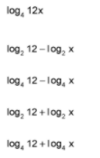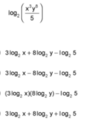Module 03: Exponential and Logarithmic Functions Flashcards
(54 cards)
Decide if the function is an exponential function. If it is, state the initial value and the base. (2 points)
y = - 7.3 ⋅ 2x
- Exponential Function; base = - 14.6; initial value = 1
- Exponential Function; base = x; initial value = - 7.3
- Not an exponential function
- Exponential Function; base = 2; initial value = - 7.3
4. Exponential Function; base = 2; initial value = - 7.3
Compute the exact value of the function for the given x-value without using a calculator. (2 points)
f(x) = 3x for x = -1
1/3
Choose the graph which matches the function. (2 points)
f(x) = 3x-4

Answer 03
The graph of an exponential function is given. Which of the following is the correct equation of the function? (2 points)
- y = 0.65x
- y = 2.4x
- y = 3.5x
- y = 0.32x

4. y = 0.32x
Decide whether the function is an exponential growth or exponential decay function, and find the constant percentage rate of growth or decay. (2 points)
f(x) = 3.6 ⋅ 1.04x
- Exponential growth function; 0.04%
- Exponential growth function; 104%
- Exponential decay function; 104%
- Exponential growth function; 4%
4. Exponential growth function; 4%
Decide whether the function is an exponential growth or exponential decay function, and find the constant percentage rate of growth or decay. (2 points)
f(x) = 2229 ⋅ 0.9909x
- Exponential decay function; -0.91%
- Exponential growth function; -0.91%
- Exponential growth function; 0.0091%
- Exponential decay function; 0.0091%
- Exponential decay function; -0.91%
Find the exponential function that satisfies the given conditions:
Initial value = 33, increasing at a rate of 7% per year (2 points)
- f(t) = 7 ⋅ 1.07t
- f(t) = 33 ⋅ 1.07t
- f(t) = 33 ⋅ 7t
- f(t) = 33 ⋅ 0.07t
2. f(t) = 33 ⋅ 1.07t
Find the exponential function that satisfies the given conditions:
Initial value = 62, decreasing at a rate of 0.47% per week.
f(t) = 62 ⋅ 0.9953t
The decay of 742 mg of an isotope is described by the function A(t)= 742e-0.03t, where t is time in years. Find the amount left after 84 years. Round your answer to the nearest mg. Show all of your work for full credit. (2 points)
A(84)=742e-0.03⋅84
A(84)=742e-2.52
A(84)=742(0.08045961)
A(84)=59.7
A(84)≈60mg
Evaluate the logarithm. (2 points)
ln e4
- e4
- 1
- 4 ln e
- 4
4. 4
Simplify: 10log109
9
Find the following using a calculator. Round to four decimal places. (2 points)
log 0.47
- -0.8279
- -0.255
- -0.755
- -0.3279
4. -0.3279
Assuming all variables are positive, use properties of logarithms to write the expression as a sum or difference of logarithms or multiples of logarithms. (2 points)

Answer: 04
Assuming all variables are positive, use properties of logarithms to write the expression as a sum or difference of logarithms or multiples of logarithms. (2 points)

Answer: 02
Use the product, quotient, and power rules of logarithms to rewrite the expression as a single logarithm. Assume that all variables represent positive real numbers. (2 points)

Answer: 01
Use the change of base rule to find the logarithm to four decimal places. (2 points)
log9 0.877
-0.0597
Solve: 4 logx + 3 logy
= log10 x4 + log10 y3 (Equality Property)
=logx4y3 (Product Property)
Find the exact solution to the equation. log5x = 2
- x = 52
- x = 5 ⋅ 2
- x = 25
1. x = 52
Find the exact solution to the equation. (2 points)
6 - log9(x+10) = 5
- x = -2
- x = -1
- x = 1
- x = 19
2. x = -1
Find the exact solution to the equation. (2 points)
5(6 - 2x) = 25
- x = 2
- x = 3
- x = 5
- x = -2
- x = 2
Find the exact solution to the equation. (2 points)
125 (1/5) 1/4 = 5
- x = 9
- x = 2
- x = 1/2
- x = 8
4. x = 8
Solve: 2ln (x + 2.8) = 3.2
x = 2.153
Decide if the function is an exponential function. If it is, state the initial value and the base. (1 point)
y = - 1.8 ⋅ 6x
- Not an exponential function
- Exponential Function; base = 6; initial value = - 1.8
- Exponential Function; base = - 10.8; initial value = 1
- Exponential Function; base = x; initial value = - 1.8
2. Exponential Function; base = 6; initial value = - 1.8
Compute the exact value of the function for the given x-value without using a calculator. (1 point)
f(x) = (1/3)x for x = -1
- 1/3
- 1/3
- 3
- -3
3. 3




